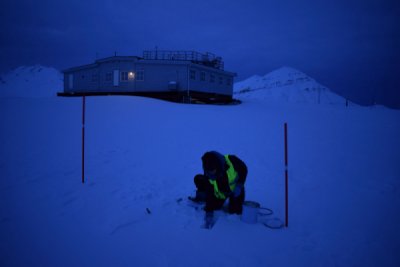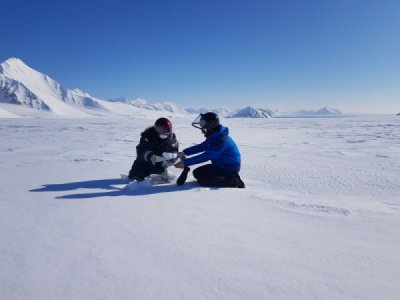The SIOS access project "Spatial VAriabiLity: VALidation dataset on POPs concentrations in snow (Sval-POPs)" was a collaboration between Gdansk University of Technology (Poland) and Institute for the Dynamics of Environmental Processes (Italy). The project team consisted of Krystyna Koziol, Alice Callegaro, Filip Pawlak, Klaudia Kosek and Niccolò Maffezzoli. The overarching aim of the project was to establish a stronger background for spatial comparisons of snow chemistry studies directed at persistent organic pollutants (POPs), with the target compounds in the PCBs (polychlorinated biphenyls) group.

of persistent organic pollutants in Ny Ålesund.
The field sampling was conducted in two locations: Hornsund and Ny-Ålesund. At each of them, a local site was picked for repeated sampling at approximately weekly intervals, and for a timespan of one month (12th April – 11th May 2019) both sites were monitored simultaneously. At Ny Ålesund, this was near the Gruvebadet air monitoring station building (Fig. 1), while in Hornsund a location near the precipitation chemical monitoring gauge was used (Fig. 2). At 7 occasions in total (2 in Ny Ålesund, 5 in Hornsund) the local sample was taken in triplicate, usually with the same type of sampling vessel. However, different sampling vessels were also checked (all were pre-cleaned and suitable for such sampling, made of either metal or Teflon). Field blanks were also collected there. The field sampling of snow was assisted by measurements of its physical properties, such as depth and density of the collected layer (Fig. 3).

Polar Station in Hornsund, to determine the spatial distribution
of POPs (persistent organic pollutants) in its snow cover.
Additionally, in each location, there was one glacier selected for a spatial study (Fig. 4a&b, Fig. 5). In Hornsund, there was also the non-glaciated valley of Revelva included (Fig. 6). The field experiment design consisted of sampling along the central line in a spacing of 0.5-1.5 km, with one point added for triplicate sample collection at a spacing of 1-3 m to gauge local variability (Fig. 4b). One field blank per valley was also taken.
Most of the collected samples were then prepared for analyses at the respective field station laboratory (Dirigibile Italia or Polish Polar Station Hornsund), using solid phase extraction (SPE) (Fig. 7). Thus, the transport of samples was simplified to taking smaller cartridges (frozen) to Italy or chilled 20 mL extracts to Poland. Only the samples collected at the end of the stay in Hornsund were transported in bulk, frozen, to the laboratory in Gdansk.
There is still a considerable amount of laboratory and data analysis work to do, but we look forward to learning more about the results of this project once this has been completed!



























